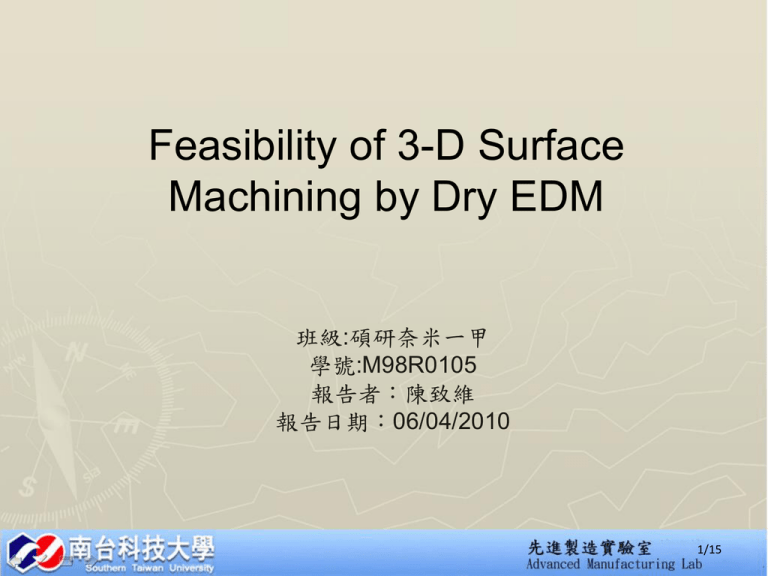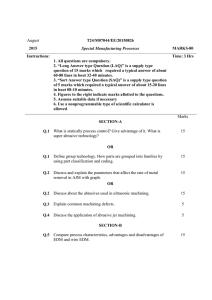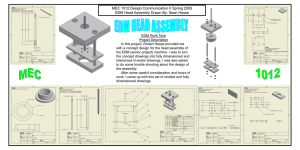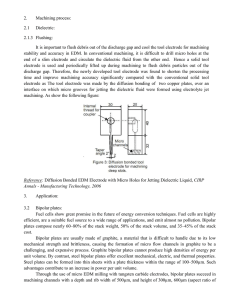Feasibility of 3-D Surface Machining by Dry EDM 班級:碩研奈米一甲 學號:M98R0105
advertisement

Feasibility of 3-D Surface Machining by Dry EDM 班級:碩研奈米一甲 學號:M98R0105 報告者:陳致維 報告日期:06/04/2010 1/15 Outline • Introduction • Experimental Method • Experimental Conditions • Machining Samples by Dry EDM • Conclusion 2/15 Introduction Over the recent years, numerous dry EDM researches are being reported in the area of EDM. Compared to conventional wet EDM methods, dry EDM has been reported to improve profile accuracy due to small tool electrode wear ratio. In this study, 3-dimensional surface machining by dry EDM was attempted to investigate the machining performance of dry EDM from the viewpoint of practical application. In machining experiments, we investigated the influence of the following parameters such as cut depth and gas pressure, pulse duration and pulse interval, Rotational speed of tool electrode, all of which are considered important in 3-dimensional surface machining by dry EDM on machining performance. 3/15 Experimental Method 1/3 Figure 1. Tool electrode spindle 4/15 Experimental Method 2/3 Table 1. Machining conditions 5/15 Experimental Method 3/3 Cutiting depth : depth of one stroke cut Target depth : sum of Cutting depth Figure 2. Tool path 6/15 Cut depth and air pressure Figure 3. Cut depth, gas pressure, and work removal rate Figure 4. Cut depth, gas pressure, and tool electrode wear ratio 7/15 Pulse duration and pulse interval The experiments were carried out at the following conditions, cutting depth of 0.1mm,oxygen gas with pressure of 2.0 Mpa. Figure 5. Pulse duration and work removal rate Figure 6. Pulse duration and tool electrode wear ratio 8/15 Effects of rotational speed of tool electrode The cut depth was set at 0.1mm and the 2.5MPa oxygen was used. Figure 7. Relation between revolution of tool electrode and work removal rate Figure 8. Relation between revolution of tool electrode and tool electrode wear ratio 9/15 Dry EDM milling samples 1/3 CuW pipe electrodes with an external diameter of Φ0.15mm and internal diameter of Φ 0.07mm were used. The workpiece was SKD-61 plate with a hardness of HRC50. The gas was oxygen with a pressure of 2.0MPa, and the machining dept h was set at 0.10mm. Machining was also carried out in oil for comparison. Figure 9. Dry EDM milling sample 10/15 Dry EDM milling samples 2/3 Measurement was carried out using a Mitutoyo non-contact sensor unit SV-3000. Figure 10. Dry EDM milling Figure 11.Oil EDM milling 11/15 Dry EDM milling samples 3/3 Table 2. Results of dry EDM 12/15 Contouring and Drilling samples Figure 12. Dry EDM contouring sample Figure 13. Dry EDM drilling sample 13/15 Conclusion a. There exist optimum combinations of gas pressure and cut depth for achieving maximum work removal rate and minimum tool electrode wear ratio in dry EDM. There also exist optimum combinations of pulse duration and stationary time. b. Micro machining was realized by dry EDM using gas. The tool electrode wear ratio was smaller with gas than oil,while the work removal rate did not change. 14/15 Thanks for your attention!! 15/15




